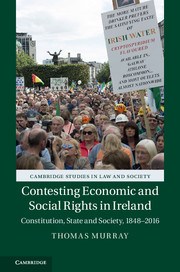Book contents
- Frontmatter
- Dedication
- Contents
- Acknowledgments
- Introduction: The Politics of Economic and Social Rights
- 1 Constitution ‘from Below’ in Ireland: 1848–1922
- 2 ‘Not Alone Personal Liberty but Economic Freedom’: Socio-economic Rights in the Making of the 1922 Irish Free State Constitution
- 3 ‘Highly Dangerous’? Socio-economic Rights in the Making of the 1937 Irish Constitution
- 4 Contesting the Irish Constitution and the World-System: 1945–2008
- 5 The Polarities of Justice and Legal Business
- 6 Contesting Property Rights
- 7 Contesting Trade Union Rights
- 8 Contesting Family, Education, andWelfare Rights
- 9 Reproducing the Value-Consensus State
- 10 Constitution ‘from Below’ in Ireland: 1945–2008
- Conclusion: Contesting Economic and Social Rights Today
- Bibliography
- Index
1 - Constitution ‘from Below’ in Ireland: 1848–1922
Published online by Cambridge University Press: 05 August 2016
- Frontmatter
- Dedication
- Contents
- Acknowledgments
- Introduction: The Politics of Economic and Social Rights
- 1 Constitution ‘from Below’ in Ireland: 1848–1922
- 2 ‘Not Alone Personal Liberty but Economic Freedom’: Socio-economic Rights in the Making of the 1922 Irish Free State Constitution
- 3 ‘Highly Dangerous’? Socio-economic Rights in the Making of the 1937 Irish Constitution
- 4 Contesting the Irish Constitution and the World-System: 1945–2008
- 5 The Polarities of Justice and Legal Business
- 6 Contesting Property Rights
- 7 Contesting Trade Union Rights
- 8 Contesting Family, Education, andWelfare Rights
- 9 Reproducing the Value-Consensus State
- 10 Constitution ‘from Below’ in Ireland: 1945–2008
- Conclusion: Contesting Economic and Social Rights Today
- Bibliography
- Index
Summary
The principle I state and mean to stand upon is this: that the entire ownership of Ireland, moral and material, up to the sun and down to the centre, is vested of right in the people of Ireland; that they, and none but they, are the landowners and lawmakers of this island…Let laws and institutions say what they will, this fact will be stronger than all laws and prevail against them, the fact that those who own your lands will make your laws and command your liberties and your lives.
– James Fintan Lalor, 1848That the first and last principle of the Irish Citizen Army is the avowal that the ownership of Ireland, moral and material, is vested of right in the people of Ireland.
– Constitution of the Irish Citizen Army, 1914A decade of popular militancy immediately preceded and decisively shaped the formation of the Irish Free State and the drafting of the Irish Free State Constitution in 1922. What has been termed the ‘Irish Revolution’ (1913–23) adhered to the conservative postcolonial trajectory outlined and critiqued by the Afro-Caribbean psychiatrist and theorist Franz Fanon, in which a nationalist party gradually substituted itself for a mass anticolonial and social movement. The Sinn Féin party effectively reasserted the principle that the masses are incapable of governing themselves, notwithstanding ample evidence to the contrary in the form of self-governing communities, arbitration courts, and soviets. This had important implications, most notably in terms of the ‘detached complicity’ between nation-building elites and the established market economy. Sinn Féin's leadership did not view the classic laws of market, property, and contract as problematic per se, rather their having being formerly skewed against ‘the Irish people’. Thus, its constitutionalism envisaged the silent reproduction of market law and the strident defence of an Irish nationalist, often specifically Catholic, culture. This national constitutionalism, as was common in many postcolonial jurisdictions, was most clearly expressed in family law, notably resulting in a remarkably enduring defence of patriarchal relations.
Popular militancy in Ireland, notably between 1917 and 1923, occurred alongside a global wave of worker militancy in the aftermath of the Russian Revolution of 1917. The nationalist movement's waging a guerrilla campaign against British rule occurred alongside Sinn Féin's creation of a state within a state while broad swathes of civil society boycotted established institutions and disrupted existing patterns of domination.
- Type
- Chapter
- Information
- Contesting Economic and Social Rights in IrelandConstitution, State and Society, 1848–2016, pp. 48 - 83Publisher: Cambridge University PressPrint publication year: 2016



